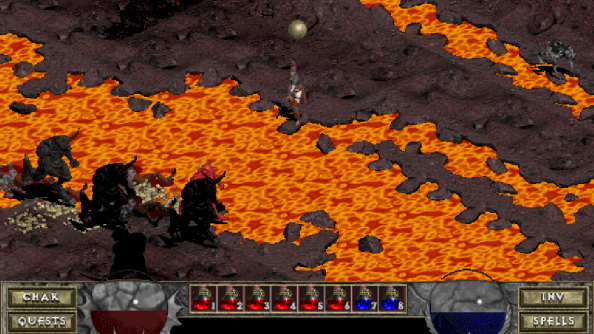DunDunDunpachi
Banned
tl;dr Diablo has always been a dumbed-down, arcade interpretation of a more hardcore genre (turn-based roguelikes). One of the key features -- multiplayer -- was an afterthought.
 www.diabloii.net
www.diabloii.net
 venturebeat.com
venturebeat.com

 www.pcgamesn.com
www.pcgamesn.com
Diablo 2 Resurrected Best Builds, Guides, and News
Icy Veins provides detailed builds, guides, and news for Diablo 2 Resurrected for all classes: amazon, assassin, barbaria, druid, necromancer, paladin, sorceress.
The guys at Blizzard Irvine had been sold on the game design and the team making it, but they didn’t know it was turn-based at first. When they found out, they argued strongly against it, pointing to the success of their own game Warcraft as an example of the intensity and fun of having to make survival decisions quickly and under pressure.
The Blizzard North devs liked real time, but didn’t think it was right for Diablo, and they argued back and forth for a while (there are lots of interesting quotes from both sides of the debate, in the sample chapter), but ultimately most of the Blizzard North team came to support the real-time theory. No one really knew until they actually tried it out though, so that very evening David Brevik tackled the project:
"I can remember the moment like it was yesterday that this happened. I was sitting and I was coding the game, and I had a warrior with a sword, and there was a skeleton on the other side of the screen. I’d been working on all this code to make characters move smoothly, doing a whole bunch of testing, and we’d talked about how the controls would work. We wanted it to be visceral. Click and swing, click and swing. We wanted it to automatically happen: If you clicked on the monster, your character would go over there and swing.
I remember very vividly: I clicked on the monster, the guy walked over, and he smashed this skeleton and it fell apart onto the ground.
The light from heaven shone through the office down onto the keyboard. I said, “Oh my God, this is so amazing!” I knew it was not only the right decision, but that Diablo was just going to be massive. It was really the most defining moment of my career, as well as for that genre of gaming. A new genre was born in that moment, and it was really quite incredible to be the person coding it and creating it. I was just there by myself coding it up. It was pretty incredible."
Branching out: How limiting skill choices made Diablo 2 more fun
Guest Are you looking to showcase your brand in front of the gaming industry’s top leaders? Learn more about GamesBeat Summit sponsorship opportunities here. On Diablo 2’s 18th anniversary, Blizzard North’s designers recount the triumphs and pitfalls of growing the game’s skill trees. In the...
Throughout the development of the original Diablo, Blizzard North’s team followed one rule. Their game had to be simple. So simple a new player could sit down and learn how to play in minutes, if not seconds. Although the game went through numerous changes—from turn-based to real time, from single-player to support for up to four adventurers over Battle.net — its singular focus remained unchanged from the project’s origins in 1995.
“Why is it so hard for developers to understand that the base core gameplay mechanic isn’t the leveling up or the item collection? It’s the clicking,” said Michio Okamura, the lead character artist on Diablo.

Diablo was originally “a single-player, turn-based DOS game,” says designer, then Battle.net happened
Y'know that Diablo, that pioneering action RPG that we all know and love? It turns out that the game that inspired so much went through a quite radical reinvention, with the end result remarkably different to the original concept.As I chatted to designer David Brevik about the forthcoming ARPG Marve
“Diablo, originally, was a single-player, turn-based DOS game that evolved into real-time action roleplaying,” he said, also explaining that the game’s mulitplayer component was only added towards the end of development when the team came up with a rather interesting idea.
“We made up Battle.net six months before the end of [development on] Diablo 1,” he said. “The idea of it came six months before the launch, so we went back and we made Diablo multiplayer.” Wait, I asked, did one of my formative experiences of online multiplayer come about almost by accident, as an afterthought? “Yeah, absolutely,” Brevik said.”But it was a great idea, that’s why we did it!”
Last edited:
